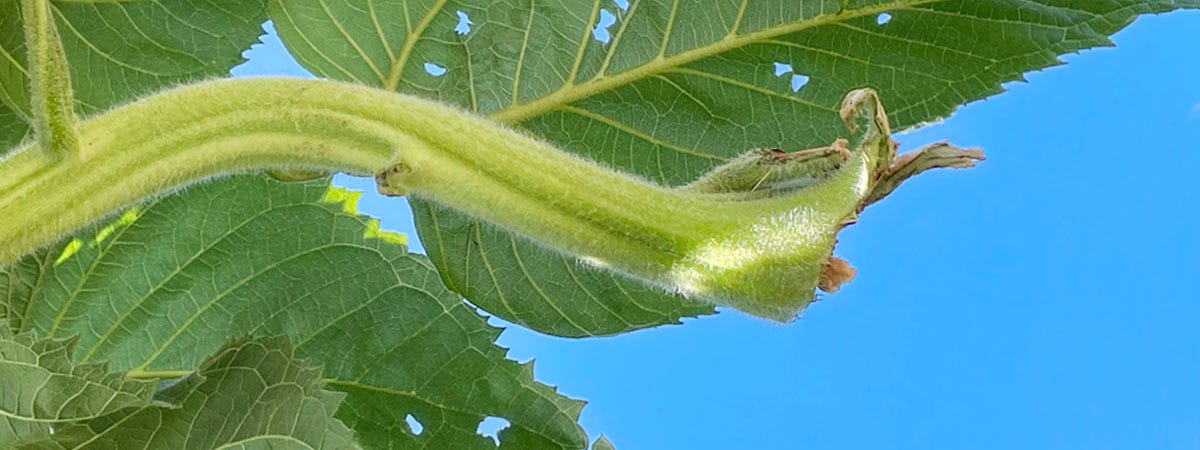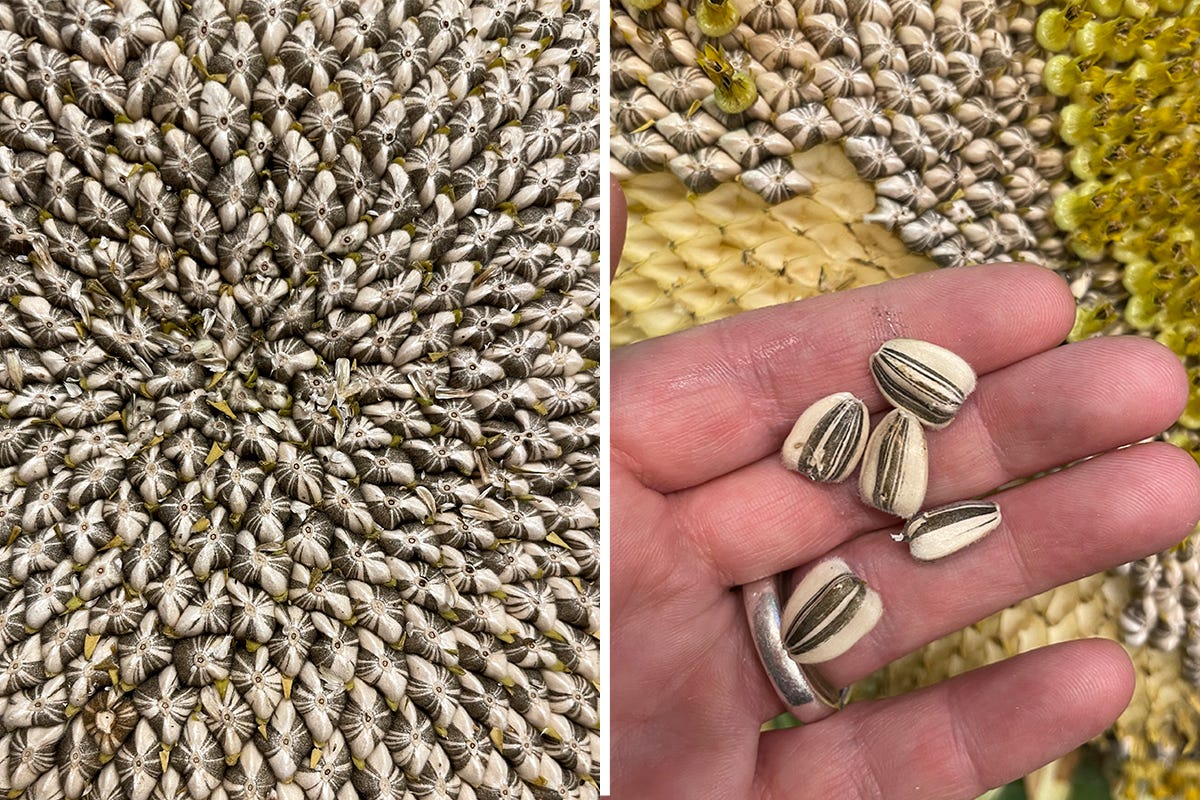Design like a sunflower
Fractaling, feeding, fixing, and nourishing in non-linear, radial regeneration
I am a design professor seeking to bridge the academics of environmental sustainability, the professional design community, and those who want to create change but don’t always know where to begin. We know the world around us is not sustainable, instead we need to find ways to design regeneratively - rejuvenating ourselves, our communities, and our planet. In this edition I use the sunflowers from my garden as a metaphor for current events, regenerative design, and thinking beyond the circular economy.
Someone stole my sunflower.
It was not an ordinary sunflower. It sprouted about five months earlier as part of a pair that grew to tower over anyone who walked by, becoming a marvel of the block. I don’t actually know how the stolen flower in question came to be, but I suspect that it was planted naturally from one of last year's flowers that went to seed, and simply fell in the soil waiting to grow. There are other sunflowers in my front yard. Some I deliberately planted neatly in a row. Others, my girls planted randomly scattering seeds around the yard. Some variations came from our next-door neighbor. Some came home from school planting projects. I made mention of the sunflowers beginning to sprout in my yard in spring when I wrote about broadening inclusion and eco-feminism. But this one particular pair of sunflower stalks grew and grew - taller than my girls, taller than me. Neighbors would walk by and share their predictions of how tall they might get. Slowly one flower opened. The other’s stem continued to grow in a wave - up and down towards the sky until it bloomed. Eventually, guesses on its height made me curious enough to get out a tape measure and a ladder. Its final height was just over 12 feet. I felt so proud, thinking surely it was close to some kind of record. (A quick google search informed me it wasn’t even close.) From my window inside I’d watch the birds come and feed on the leaves. Up close outside I’d watch the bees buzz in it. I’d talk with neighbors who walked by marveling at how tall it was, how magnificent it was, and how happy it made them. I sent photos to friends and family - wishing them well, sending sunshine, or reminders that life isn’t always a straight line. The head slowly began to die, as all living things do. Nonetheless, I left them up in the yard. There was still plenty of food left for the birds and insects, beauty and conversation to be had with passerby-ers, and I wanted to let it dry out to go to seed.
Then one Sunday afternoon I went to take our dog out and noticed the larger of the two sunflower heads was gone. “Someone took my sunflower!” I called out to my neighbor who was in his yard and came to look. We both stood in shock. Who would take it? What would they want with it? What was its value to them? Did they want the seeds? Did they think it was beautiful and wanted it for themselves? Was it a prank? (We ruled out an animal by the look of the cut.) I live in an urban area - I’m used to packages stolen from porches, smashed car windows, catalytic converter thefts, stolen bikes, and fruits and vegetables snatched from yards. But the theft of this sunflower head hit me as a deep violation of personal and communal space.
I found myself in a state of grief. The sunflower was not just stolen from me, it was stolen from the birds, the bees, the insects, the squirrels, the neighbors, the kids, and our ecosystem - small and large. But my grief wasn’t just about the sunflower. The theft was also a metaphor, a symbol of the larger attack on our collective. It is symbolic of the theft of women's rights, the theft of environmental protections, and the theft of our commons.
Creating something larger than yourself
In college, I had a friend who was intensely serious in his studies, critical of everything we learned and why. I remember a specific conversation we had about his analysis of painting instructors and had divided them into two categories - those who wanted to teach to show off their strengths and talents, and those who wanted to teach to inspire and grow their students to someday be better than them. It was such a small conversation in our freshman year apartment-style dorms, but I’ve remembered this ever since. I think of it often in my teaching and pedagogy. How do I design lessons and lectures so that my students will learn more, go farther, and have a greater impact than myself and my generation?
When I think of my work in regenerative design, I hope that my impact comes not from the “stuff” that I create but from the students I teach and the designs I influence that will continually evolve conversations, and change mindsets and cultures.
Regenerative design is about creating something that is bigger than yourself, that has the power to grow, to radiate, to fractal in different directions.
My sunflower was this - something bigger than any one individual. Literally at 12 feet tall, it physically was larger. But regenerative design is not just about being larger in a linear sense - it’s the growth of multiplicities through renourishing, replenishing, and restoring. This sunflower was feeding animals and insects, nourishing the soil below, and bringing joy to people passing by.
Harvesting seeds
When a few seeds started to fall from the remaining giant sunflower, I decided I would take it down so I could harvest the seeds. I needed a large knife to cut it. As I sawed it off I imagined whoever had taken the other one had done the same selfishly and intentionally taking it for themself. I brought it inside and marveled at the seeds which had grown in spirals of Fibonacci numbers. There were thousands of seeds. As I picked them off I began to wonder what I would do with so many seeds. And I had more flowers too, with even more seeds. I thought of my stolen sunflower and wondered where those seeds had ended up. In realizing the abundance of the seeds I had, my grief began to fade for what was taken. I started to imagine all of the ways I might share these seeds with others.
Meanwhile, new sunflowers grow in my yard of various sizes and colors, and varieties. They feed the birds, the bees, the insects, and nourish the soil. They will make the neighbors smile. They will continue to grow. Some may also be stolen. Each one will create more seeds.
My sunflower was stolen. My rights and my daughters' rights as women were stolen. The environmental protections to help our planet and the human species have been stolen. It’s tragic. It’s painful. It’s anger-producing. But, that one giant sunflower wasn’t the only thing growing in the yard. We must remember that other work has been done, and new seeds are being planted. Roe may have been overturned, but something bigger has been growing. Some elected officials may be blocking environmental protections, but something bigger has been growing. Despite the setbacks, despite the doom and gloom, new seeds have been planted that we can not ignore. It’s up to us to make sure they keep growing and to keep harvesting and keep planting. In the same way that the sunflower serves multiples, our designs must also do the same - influencing these conversations, actions, and ways of being.
Designing like a sunflower
I have no way of knowing the intentions of the thief of my sunflower. It would appear the intentions of those stripping women of their rights are related to power and control. Those who are blocking environmental protections have an interest in short-term profits and monetary gains. There is selfishness in all of these - a desire for control over others, greed in acquiring more, not for the greater good of the community but for individual wants. This brute force design mentality is what has led to our current cultural and climate collapse. Rather than continue this pattern, how might we design like a sunflower?
How might we design not for control, but for flow - living with nature, instead of trying to control it? How might we design not for one, but for many? How might we design not the acquisition of stuff, but for a regenerative restoration? Underlying these questions is a call for systems change, an entirely different way of thinking and interacting with one another and the planet.
For some time environmentalists and sustainable designers alike have called for a move towards a circular economy; away from the linear approach of “take, make, waste” model toward one that reuses, recycles, or restores all materials. The Ellen MacArthur Foundation has popularized this idea for academics and consumers alike on a large scale. Target has pledged to bring the curricular economy to its stores via refillable bottles and other products. While the circular economy has many positive solutions, it remains rooted in a consumerist and somewhat individual mentality focused on how we consume goods and services. Instead of thinking about taking a line and making it a circle (as is often used in its graphical representation), as designers we need to think of how the circle can become radial and dimensional - spanning across uses multiplicities.
A design where one seed has the power to feed nature, people, and the environment. A design where one seed creates thousands more. A design where if one is stolen, many remain, continuing to regenerate. Part of this equation means considering not only the creation of stuff, but how we interact with it, how we talk about it, and how we share it with others. What might our world look like if everything we consumed also fed nature, conversation and conservation, and community?










